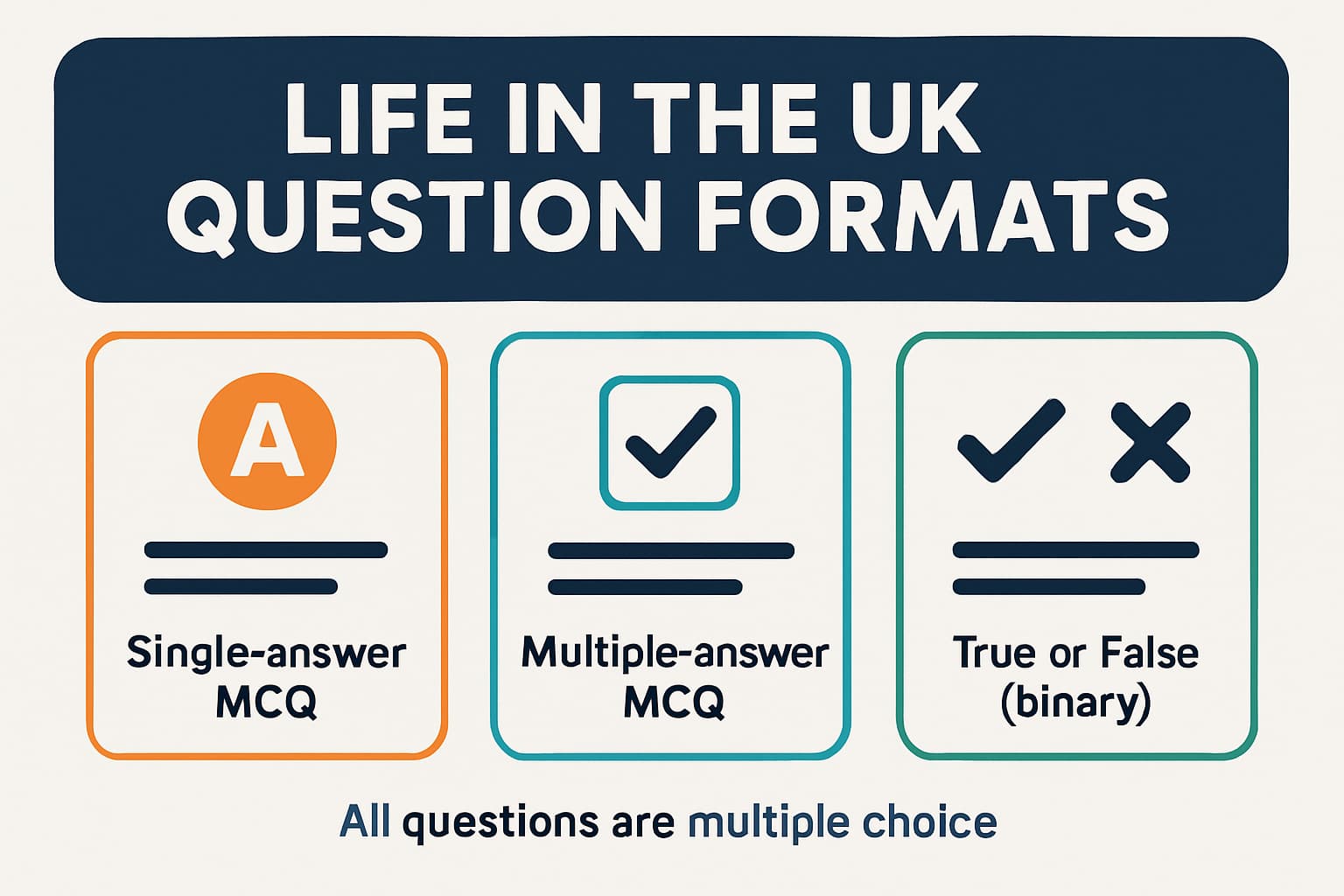Are all Life in the UK types of questions multiple choice?

Wondering if every Life in the UK Test question is multiple choice? Good news: it is. Knowing the exact types of questions you will face lets you practice with purpose and avoid costly retakes. In this guide, you will learn the three on-screen formats, what you will never see in the exam, and fast strategies to read stems, avoid traps, and practice realistically.
If you are new to the exam, start with an overview in What is the Life in the UK Test? and our 2025 step-by-step format tour. Then use the tips below to fine-tune how you answer each format.
The short answer and why it matters
Short answer: Yes — the Life in the UK Test uses a multiple choice citizenship test format for all scored items. The exam is computer-based, lasts 45 minutes, and contains 24 multiple choice questions drawn at random from a large bank. Sources: UK Home Office guidance, DavidsonMorris.
Within those types of questions, you may be asked for a single answer or more than one answer. You are tested only on information in the official handbook (official FAQ), and at the start there may be non-scored practice items to get used to the system (official FAQ).
Why this matters: knowing the exact formats helps you practice accurately and pace yourself.
Pass protection: questions are random and vary in difficulty, so mastering all formats reduces surprises (source).

The three formats you’ll encounter
All formats are multiple choice. On-screen, you will typically see one of these types of questions:
Single-answer MCQ: one correct option from several.
Multiple-answer MCQ: the prompt tells you to select two or more.
True/False (binary): a two-option multiple-choice statement (functionally the same as MCQ).
For realistic examples, check our breakdown of typical items in Life in the UK test questions: real Q&As.
Single-answer MCQs (radio buttons)
How it looks: round radio buttons where selecting one de-selects others. This is the classic multiple choice citizenship test format.
Best-practice approach:
Read the question stem twice, then scan options for obvious mismatches.
Eliminate distractors that contradict the official handbook.
When torn between two, choose the one that matches precise dates, numbers, or definitions from the handbook.
Multiple-answer MCQs (checkboxes)
How it looks: square checkboxes and a clear instruction like “Select 2 answers” or “Select all that apply.” Some questions require more than one correct answer — the FAQ and guidance confirm you must provide the exact number requested (source).
Verification steps:
Find the instruction line (e.g., “Select 2 answers”).
Tick your certainties first; then add the last choice only if it meets the stem exactly.
Count your selections before submitting to match the required number.
True/False statements (binary choice)
How it looks: a statement followed by two options. Although phrased as true/false, this is still a multiple-choice item with two choices.
Tip: treat it like a single-answer MCQ. If any part of the statement is inaccurate (date, person, place), mark False.
What you won’t face in this exam
To avoid myths, here is a quick “not included” list based on official guidance:
No essays or short-answer typing — all scored items are multiple choice (Home Office guidance).
No image/audio puzzles — questions are text-based and drawn from the official handbook (official FAQ).
No off-handbook trivia — you are tested only on the contents of “Life in the UK: A Guide for New Residents” (official FAQ).
No fixed set of questions — items are randomly generated and difficulty can vary (source).
How to read stems and avoid traps
Many misses are not knowledge gaps but stem-reading errors. Use this 4-step method to reduce mistakes:
Underline the ask: date, number, person, or definition?
Spot qualifiers: words like “only,” “always,” “best,” “not.”
Match the scope: UK-wide vs. England-only; century vs. decade.
Eliminate distractors that mix up dates, names, or locations.
Look for qualifiers (“only,” “always,” “best”)
Extreme wording is a classic distractor. If an option says something is always true, check the handbook for exceptions. If a choice claims the “best” or “only” answer without context, it is often incorrect.
Marking multiple answers without second-guessing
For “select two/select all that apply” items, use this quick rule:
Confirm the exact number in the instruction line before you read options.
Lock in certainties first, then justify any remaining selection with a handbook fact.
Count before submit — mismatched counts waste points.
Speedy verification for True/False facts
Give yourself 10–15 seconds to run this check:
Scan for absolutists (always/never/only) — likely False unless the handbook states it plainly.
Cross-check the anchor — the key date, monarch, or location.
Partial inaccuracy = False — one wrong detail makes the whole statement False.
For more pitfalls to sidestep, read 7 Common Life in the UK Test Mistakes to Avoid.
Practice that mirrors the real interface
Realistic practice boosts recall under pressure. The official guidance confirms the test is PC-based, timed, and scored on the day (Home Office guidance). Because questions are random and you must pay for retakes (Home Office), simulating the interface and pacing is vital.
Timebox practice to 45 minutes for 24 questions.
Mix difficulties to mimic random selection.
Review explanations immediately to fix weak spots.
For detailed drills, see Practice Tips 2025.
Use Hard Mode to stress-test your recall
In the Life in the UK Test App, Hard Mode ups the challenge across all formats (single-answer, multiple-answer, and binary) to surface knowledge gaps fast. It is designed to mirror the feel of a tough, randomly generated set.
Track your readiness by question type
Brit-Bear, your smart learning assistant, plus a readiness score and analytics by topic and format, help you see whether single-answer, multiple-answer, or binary items need more work. The app’s 650+ question bank with detailed explanations, mock tests, and offline access make steady, focused study easier.
Prepare with the Life in the UK Test App. Download on App Store: https://apps.apple.com/app/id6743702124, Get it on Google Play: https://play.google.com/store/apps/details?id=net.briceventures.life_in_the_uk_test
Quick FAQs on question formats
Are there trick questions?
Not intentionally, but distractors use extreme words or mix up dates and places. Read stems slowly and watch for qualifiers like “always,” “only,” and “best.”
Can a question have more than two correct answers?
Yes. The instruction will specify how many to select (e.g., “Select 3”). Always match your selection count to the prompt.
How many questions and how long is the test?
24 multiple choice questions in 45 minutes. You get your result the same day.
Where do questions come from?
Only from the official “Life in the UK: A Guide for New Residents” handbook content.
What languages can I take the test in?
English nationwide, Welsh in Wales, and Scottish Gaelic in Scotland (at respective centers).
Can I retake if I fail?
Yes, there is no limit, but you pay each time, and each test draws a different random set.
Next steps
Review the full format tour: Life in the UK Test format: a 2025 step-by-step tour.
Drill with realistic questions: real Q&As you can expect.
Avoid common errors: 7 mistakes to avoid.
Practice smarter: Ace the questions with our 2025 tips.
Ready to practice by format and pass with confidence? Get the Life in the UK Test App on App Store or Google Play.